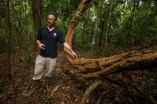(Press-News.org) Tropical forests are a sometimes-underappreciated asset in the battle against climate change. They cover seven percent of land surface yet hold more than 30 percent of Earth's terrestrial carbon. As abandoned agricultural land in the tropics is taken over by forests, scientists expect these new forests to mop up industrial quantities of atmospheric carbon. New research by Smithsonian scientists shows increasingly abundant vines could hamper this potential and may even cause tropical forests to lose carbon.
In the first study to experimentally demonstrate that competition between plants can result in ecosystem-wide losses of forest carbon, scientists working in Panama showed that lianas, or woody vines, can reduce net forest biomass accumulation by nearly 20 percent. Researchers called this estimate "conservative" in findings published this month in Ecology.
"This paper represents the first experimental quantification of the effects of lianas on biomass," said lead author Stefan Schnitzer, a research associate at the Smithsonian Tropical Research Institute and professor at the University of Wisconsin-Milwaukee. "As lianas increase in tropical forests, they will lower the capacity for tropical forests to accumulate carbon."
Previous research by Schnitzer and others demonstrated that lianas are increasing in tropical forests around the globe. No one knows why. Decreased rainfall is one suspect, but lianas, which are generally more drought-tolerant than trees, are increasing in abundance even in rainforests that have not experienced apparent changes in weather patterns.
Lianas climb trees to reach the forest canopy where their leaves blot out the sunlight required for tree growth. They account for up to 25 percent of the woody plants in a typical tropical forest, but only a few percent of its carbon. They do not compensate for displaced carbon due to relatively low wood volume, low wood density and a high rate of turnover.
Machetes in hand, Schnitzer and colleagues chopped lianas out of forest plots for this study. After collecting eight years of data comparing liana-free plots with naturally liana-filled plots in the same forest, they quantified the extent to which lianas limited tree growth, hence carbon uptake. In gaps created by fallen trees, lianas were shown to reduce tree biomass accumulation by nearly 300 percent. Findings by Schnitzer and colleagues, also published this year in Ecology, showed that liana distribution and diversity are largely determined by forest gaps, which is not the case for tropical trees.
Arid conditions in gaps are similar to recently reforested areas. "The ability of lianas to rapidly invade open areas and young forests may dramatically reduce tropical tree regeneration — and nearly all of the aboveground carbon is stored in trees," said Schnitzer. Lianas have been shown to consistently hinder the recruitment of small trees, and limit the growth, fecundity and survival of established trees.
"Scientists have assumed that the battle for carbon is a zero-sum game, in which the loss of carbon from one plant is balanced by the gain of carbon by another. This assumption, however, is now being challenged because lianas prevent trees from accumulating vast amounts of carbon, but lianas cannot compensate in terms of carbon accumulation," said Schnitzer. "If lianas continue to increase in tropical forests, they will reduce the capacity for tropical forests to uptake carbon, which will accelerate the rate of increase of atmospheric carbon worldwide."
INFORMATION:
The Smithsonian Tropical Research Institute, headquartered in Panama City, Panama, is a unit of the Smithsonian Institution. The Institute furthers the understanding of tropical nature and its importance to human welfare, trains students to conduct research in the tropics and promotes conservation by increasing public awareness of the beauty and importance of tropical ecosystems. Website: http://www.stri.si.edu.
Vines choke a forest's ability to capture carbon, Smithsonian scientists report
2014-05-27
ELSE PRESS RELEASES FROM THIS DATE:
Where have all the craters gone?
2014-05-27
Boulder, Colo., USA – Impact craters reveal one of the most spectacular geologic process known to man. During the past 3.5 billion years, it is estimated that more than 80 bodies, larger than the dinosaur-killing asteroid that struck the Yucatan Peninsula 66 million years ago, have bombarded Earth. However, tectonic processes, weathering, and burial quickly obscure or destroy craters. For example, if Earth weren't so dynamic, its surface would be heavily cratered like the Moon or Mercury.
Work by B.C. Johnson and T.J. Bowling predicts that only about four of the craters ...
Cancer, bioelectrical signals and the microbiome connected
2014-05-27
MEDFORD/SOMERVILLE, Mass. (May 27, 2014) -- Developmental biologists at Tufts University, using a tadpole model, have shown that bioelectrical signals from distant cells control the incidence of tumors arising from cancer-causing genes and that this process is impacted by levels of a common fatty acid produced by bacteria found in the tadpole and also in humans.
"Genetic information is often not enough to determine whether a cell will become cancerous; you also have to take into account the physiology of the cell and the bioelectrical signals it receives from other ...
Moderate-intensity physical activity program for older adults reduces mobility problems
2014-05-27
Among older adults at risk of disability, participation in a structured moderate-intensity physical activity program, compared with a health education intervention, significantly reduced the risk of major mobility disability (defined in this trial as loss of ability to walk 400 meters, or about a quarter mile), according to a study published by JAMA. The study is being released early online to coincide with its presentation at the American College of Sports Medicine annual meeting.
Mobility—the ability to walk without assistance—is a critical characteristic for functioning ...
Maintaining mobility in older adults can be as easy as a walk in the park
2014-05-27
With just a daily 20-minute walk, older adults can help stave off major disability and enhance the quality of their later years, according to results of the Lifestyle Interventions and Independence for Elders (LIFE) Study, conducted by researchers at Yale School of Medicine in collaboration with seven other institutions around the country. The study is published in the May 27 issue of the Journal of the American Medical Association.
Mobility, the ability to walk without assistance, is key to functioning independently. Reduced mobility is common in older adults and is ...
Study proves physical activity helps maintain mobility in older adults
2014-05-27
GAINESVILLE, Fla. — It's something we've all heard for years: Exercise can help keep older adults healthy. But now a study, the first of its kind to look at frail, older adults, proves that physical activity can help these people maintain their mobility and dodge physical disability.
A new University of Florida study shows daily moderate physical activity may mean the difference between seniors being able to keep up everyday activities or becoming housebound. In fact, moderate physical activity helped aging adults maintain their ability to walk at a rate 18 percent higher ...
What what role does MSG play in obesity and fatty liver disease?
2014-05-27
New Rochelle, NY, May 27, 2014—The commonly used food additive monosodium glutamate (MSG) has been linked to obesity and disorders associated with the metabolic syndrome including progressive liver disease. A new study that identifies MSG as a critical factor in the initiation of obesity and shows that a restrictive diet cannot counteract this effect but can slow the progression of related liver disease is published in Journal of Medicinal Food, a peer-reviewed journal from Mary Ann Liebert, Inc.. The paper is available on the Journal of Medicinal Food website.
Makoto ...
Scientists unveil first method for controlling the growth of metal crystals
2014-05-27
Researchers have announced the first ever method for controlling the growth of metal-crystals from single atoms.
Published in the journal Nature Communications and developed at the University of Warwick, the method, called Nanocrystallometry, allows for the creation of precise components for use in nanotechnology.
Professor Peter Sadler from the University's Department of Chemistry commented that "The breakthrough with Nanocrystallometry is that it actually allows us to observe and directly control the nano-world in motion".
Using a doped-graphene matrix to slow ...
Investigating the pleasure centers of the brain: How reward signals are transmitted
2014-05-27
This news release is available in French. New research presented today by Dr. Jonathan Britt, from McGill University, helps to better understand how reward signals, such as those produced by addictive drugs, travel through the brain and modify brain circuits. Dr. Britt obtained these results using optogenetics, which use light-responsive proteins to study the activation of neural circuits in distinct locations, allowing the researcher to precisely dissect the roles of different neural circuits in the brain. Dr. Britt's studies have helped reveal circuits that are responsible ...
Making the right choices in changing circumstances: Cognitive flexibility in the brain
2014-05-27
This news release is available in French. Choosing what is best is not always simple. Should one choose a small, certain reward, or take risks and try to get a larger reward? New research by Stan Floresco, from the Brain Research Centre at the University of British Columbia sheds light on the brain circuits that interact to help us decide the best strategy to adopt in changing circumstances. These results were presented at the 8th annual Canadian Neuroscience Meeting, taking place May 25-28 2014 in Montreal, Canada.
The studies of Dr. Floresco and his team used ...
Scientists develop new hybrid energy transfer system
2014-05-27
Scientists from the University of Southampton, in collaboration with the Universities of Sheffield and Crete, have developed a new hybrid energy transfer system, which mimics the processes responsible for photosynthesis.
From photosynthesis to respiration, the processes of light absorption and its transfer into energy represent elementary and essential reactions that occur in any biological living system.
This energy transfer is known as Forster Resonance Energy Transfer (FRET), a radiationless transmission of energy that occurs on the nanometer scale from a donor molecule ...


